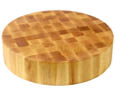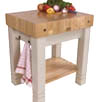|
|
How Safe is Your Kitchen?
WHEN mad cow disease was discovered in Washington State recently, it made headlines for days and brought action from the federal government. Coupled with a number of E. coli scares, it caused some Americans to swear off hamburger. But most people don't seem to worry about what experts say is a petri dish for food-borne illness: the home kitchen. "Everybody is so acutely aware of mad cow disease," said Janet Anderson, a clinical associate professor of nutrition and food sciences at Utah State University, "but people aren't aware of the fact that they don't even wash their hands when they enter their kitchens, which is a much greater risk." Professor Anderson filmed more than 100 people preparing dinner and found that only two did not cross-contaminate raw meat with fresh vegetables. It is not only people's hands, though. Dish towels, sinks, refrigerator door handles and warm, moist, crevice-filled sponges are also breeding grounds for bacteria. "A sponge that's been in use for no more than two or three days in a kitchen will harbor millions of bacteria," said Elizabeth Scott, co-director of the Simmons Center for Hygiene and Health in the Home at Simmons College in Boston. That's a problem, she said, "if you pick up the pathogen or a pathogenic E. coli, salmonella or campylobacter on the sponge." She added: "That means that any time you use the sponge to wipe up a surface you are potentially spreading those pathogens." These pathogens are a potential problem mainly for infants, the sick elderly and people with compromised immune systems. But when allowed to multiply on food, they can make the average person sick." The basic reality is that the risks that scare people and the risks that kill people are very different," said Dr. Peter M. Sandman, a risk communication consultant in Princeton, N.J. "Risks that you control," Dr. Sandman said, "are much less a source of outrage than risks that are out of your control. In the case of mad cow, it feels like it's beyond my control. I can't tell if my meat has prions in it or not. I can't see it, I can't smell it. However, dirt in my own kitchen is very much in my own control. I can clean my sponges. I can clean the floor." Dread is another factor, Dr. Sandman said. People can deal with sick stomachs, but they absolutely dread the idea of rotting brains. Fair enough, except that many of the estimated 76 million cases of food-borne illnesses in the United States each year are contracted in the home, and many can be prevented. Dean Cliver, a professor of food safety at the University of California, Davis, found that microwaving sponges, cellulose sponges, not the natural kind "We did soak sponges in some pretty bad things," he said, "and one minute in the nuke and that pretty much did it." A great way to sanitize your kitchen sponge is to wet it and put it in the microwave for 60 seconds (or until it is steaming). Wait a minute or two before removing it from the microwave. Take extra care as it might be hot when you remove it and let it air dry. Dishcloths also become saturated with bacteria, although since they dry more quickly than sponges, bacteria are less likely to breed. They can be microwaved, too, or simply laundered regularly. Professor Cliver's other notable discovery involved cutting boards. "Somewhere along the line, wood got a bad name," Professor Cliver said. Part of the blame, he said, must go to the rubber industry, which assailed wood cutting boards in order to promote hard rubber and plastic. In recent years, it has become conventional wisdom that plastic cutting boards are safer and easier to clean than wood cutting boards. Even the Food and Drug Administration says that plastic is less likely to harbor bacteria and easier to clean. But in a study Professor Cliver conducted, he found that cellulose in wood absorbs bacteria but will not release it. "We've never been able to get the bacteria down in the wood back up on the knife to contaminate food later," he said. Plastic absorbs bacteria in a different way. "When a knife cuts into the plastic surface, little cracks radiate out from the cut," Professor Cliver said. The bacteria, he said, "seem to get down in those knife cuts and they hang out. They go dormant. Drying will kill, say, 90 percent of them, but the rest could hang around for weeks." In one test he did, raw chicken juices were spread on samples of used wood and plastic cutting boards. Both boards were washed in hot soapy water and dried, then knives were used to simulate cutting vegetables for a salad. No bacteria appeared on the knives cut on wood, but there were plenty on the knives and on the plastic board. Professor Cliver found that running plastic boards through the dishwasher only spread the bacteria around. The bacteria in the cracks remained. He said that the water in dishwashers must get hotter than 140 degrees or all sorts of bacteria can survive. Wood cutting boards may be microwaved for five minutes, but Professor Cliver warned that some wood cutting boards contain metal pieces within. He added, "Some people who tried their boards in the microwave had some spectacular fireworks." Even with clean sponges and cutting boards, no one's kitchen will ever be germ-free because the food supply is not sterile. In 1998, Consumer Reports, for instance, found that 71 percent of store-bought chicken contained harmful bacteria. Most bacteria in food can be killed if the food is cooked properly. But much of the harm happens before the food gets near the oven. In an experiment performed by Professor Anderson of Utah State University, she and her colleagues covered a chicken with a product called Glo Germ, which is invisible in daylight but visible when exposed to ultraviolet light. The chicken was given to a home cook, who was asked to prepare it. By the time the chicken was done, Professor Anderson said, the light revealed chicken juices everywhere. On the counter and in the sink, on cabinet handles and even on the sippy cup of the cook's 2-year-old child. Chuck Gerba, a professor of environmental microbiology at the University of Arizona who has studied bacteria in home kitchens, said that he found that people who had the cleanest-looking kitchens were often the dirtiest. Because "clean" people wipe up so much, they often end up spreading bacteria all over the place. The cleanest kitchens, he said, were in the homes of bachelors, who never wiped up and just put their dirty dishes in the sink. The biggest obstacle seems to be simply getting people to wash their hands. Professor Anderson found that only 34 percent of her subjects washed their hands before cooking, and most failed to use soap. Washing hands in hot soapy water for at least 20 seconds rinses off surface bacteria and makes it difficult for bacteria to cling to skin. The less bacteria that you pick up, the less likely you will fall ill. Getting people to change their habits, however, is a big mountain to climb. The truth is, as Dr. Sandman pointed out, bacteria in the home kitchen is simply not mysterious or weird enough. To respond to it, you have to do something very simple: wash your hands. And that's just not as compelling as taking a dramatic stand and halting beef consumption.
Chefs Note: Wash your hands as often as possible, teach others to do the same. Clean as you go. Sanitize everything on a regular basis! Use John Boos Maple Cutting boards! Click on pictures below! Visit www.chefdepot.net and please tell your friends!
|
|

Copyright 1999 - 2024 Chef Depot Inc.
All Rights Reserved.
Legal Notice and Copyright
Customer
Service - E-mail us or phone:(630)
739-5200 Sanitation, Foodservice, Clean as you go, #HACCP, #Chefs #Cooks @Cooking #Channel Tips and Products for a Safer Kitchen
|





